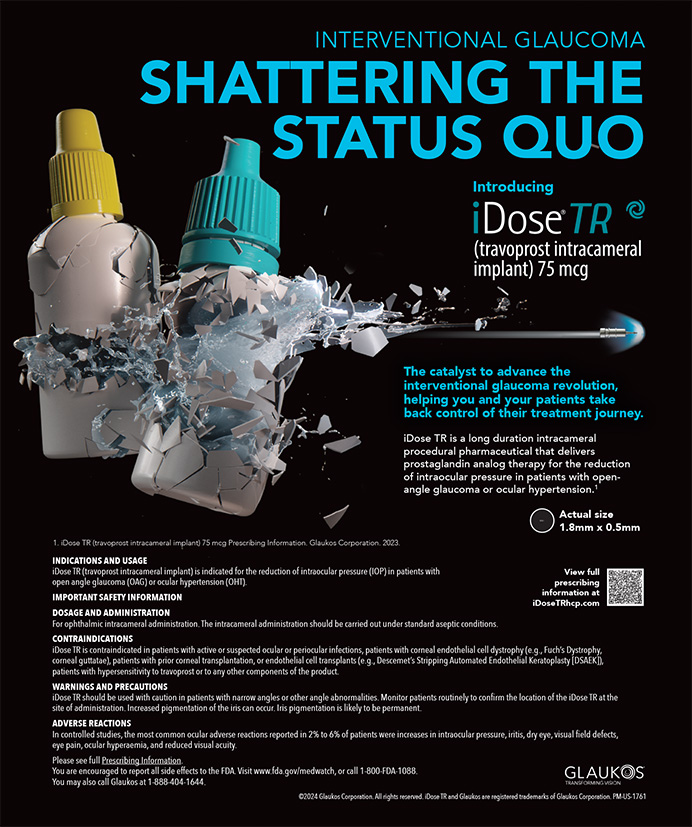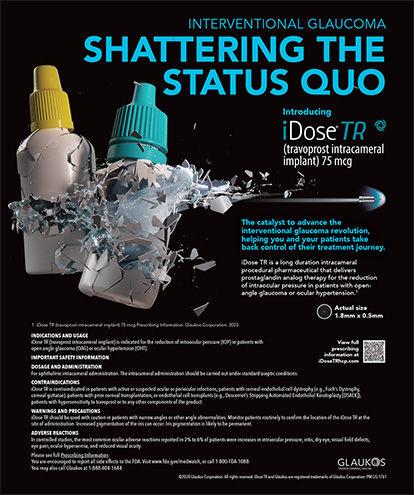Recently, I performed phacoemulsification in a challenging case of pseudoexfoliation. This article describes the techniques and tools I used to achieve an excellent outcome.
THE EXAMINATION
During the preoperative slit-lamp examination, I noted the classic sign of white, flaky “dandruff” debris on the anterior capsule and pupillary margin. I carefully looked for iris transillumination defects, and I evaluated the patient for any risks of early glaucoma that can sometimes be found with pseudoexfoliation. There was no significant pigment deposition in the trabecular meshwork. Visual field testing with the Humphrey Field Analyzer (Carl Zeiss Meditec, Inc., Dublin, CA) was normal, and I noted no optic nerve cupping when evaluating the retinal nerve fiber layer using optical coherence tomography.
I examined the pupillary size, which appeared normal, and looked for any evidence of iridodialysis or phacodonesis with gonioscopy. The pupillary size and illumination did not appear to be significantly affected. During the informed consent process, I took extra time with the patient. I explained that she had additional risks regarding capsular support because of her preexisting weak zonules. I stated that it might be necessary to place a capsular tension ring in the capsule with the IOL. I further informed her that I might have to abort placing a one-piece implant and use a three-piece IOL in the sulcus instead or even an ACIOL if support were compromised.
PREPARATION AND TOOLS
Prior to starting surgery and aware of the potential risks of a pupil that might not dilate well, I had a 7-mm Malyugin Ring (MicroSurgical Technology, Redmond, WA) available in the room. Fortunately, pupillary dilation was adequate, and after I created two corneal incisions, the pupil maintained its shape and integrity. In select cases, I favor using VisionBlue (Dutch Ophthalmic Research Company, Zuidland, Netherlands) to better visualize the capsule as I perform my capsulorhexis. The dye also helps me to identify wrinkles indicating zonular weakness in the capsule, and it allows me to see the capsular edges well.
After I formed the capsulorhexis, I performed careful hydrodissection with the Chang cannula. During this step, the iris prolapsed somewhat, so I used Healon5 (Abbott Medical Optics Inc., Santa Ana, CA) and an iris spatula to redeposit the iris. To prevent further prolapsing of the iris, I placed an interrupted suture near the 2.85-mm incision and made a new incision higher in the cornea. To minimize disruption during the nuclear removal and in case there were a loss of up to four clock hours of integrity, I inserted a standard 12.3 Morcher Capsular Tension Ring (CTR; Morcher GmbH, Stuttgart, Germany; distributed in the United States by FCI Ophthalmics, Inc., Marshfield Hills, MA).
In this case, I felt it would be safer to place the CTR prior to the removal of the nucleus with the phaco probe. I inserted the CTR with a Geuder injector (Geuder AG, Heidelberg, Germany) after I hydrated and delineated the nucleus. It is easier to place a CTR in the capsule after the nucleus and cortical material have been removed and the capsule is filled with viscoelastic. By injecting the device sooner, I felt confident of greater support for performing phacoemulsification. Cortical cleanup, of course, became more challenging.
CONCLUSION
Thorough preparation and an anticipation of potential variables allowed me to achieve a great outcome in this complicated cataract case. Advanced technologies such as CTRs, VisionBlue, Healon5, and the Malyugin Ring augment surgeons’ ability to address the unexpected successfully.
A video of phacoemulsification in the setting of pseudoexfoliation is available at http://eyetube.net/?v=zebul.
Damien F. Goldberg, MD, is in private practice at Wolstan & Goldberg Eye Associates in Torrance, California. He acknowledged no financial interest in the products or companies mentioned herein. Dr. Goldberg may be reached at (310) 543-2611; damien.goldberg@wolstaneye.com.


